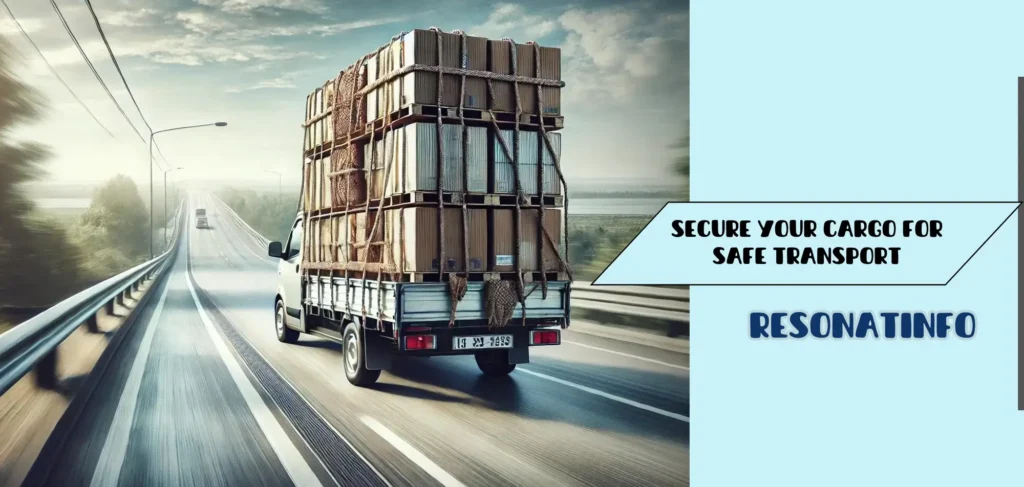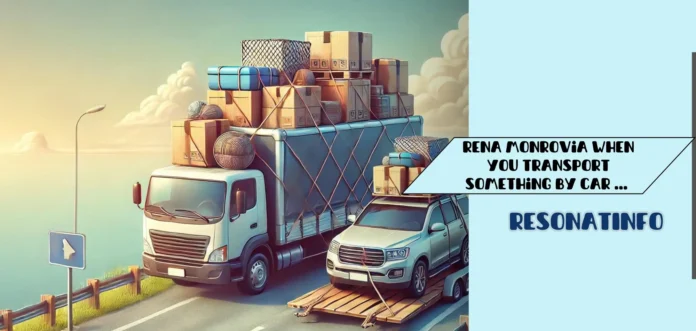Transporting goods by car is an essential part of everyday life, whether you’re moving house, delivering items, or taking things on a road trip. Ensuring that the items you’re transporting arrive safely and intact is important. But sometimes, people overlook the details of proper car transportation, leading to potential problems on the road.
The phrase “Rena Monrovia when you transport something by car …” has a mysterious ring to it. While it may seem unfamiliar, it speaks to the challenges and considerations involved in transporting goods by car.
KEY POINTS
- Always choose the right vehicle based on the size and weight of your cargo.
- Secure your cargo with ropes, straps, or nets to prevent accidents.
- Plan your route, avoiding hazardous areas and traffic jams.
- Drive cautiously, adjusting your speed and distance based on the load.
- Regularly inspect your vehicle to ensure it’s in safe condition for transportation.
What Does ‘Rena Monrovia When You Transport Something by Car’ Mean?
Breaking down the phrase “Rena Monrovia” requires some historical context. The MV Rena was a cargo ship that infamously ran aground off the coast of New Zealand in 2011. Registered in Monrovia, Liberia, the ship became a symbol of the dangers of poorly managed transportation. The connection to Monrovia highlights the importance of proper oversight in transporting goods—whether by sea or car.
When you apply this to car transportation, the message is clear: careful planning and attention to detail are essential for avoiding accidents and mishaps. Transporting something by car, no matter how simple it seems, requires thoughtful preparation, just as maritime transport does.
Transporting Items by Car: Key Considerations
When transporting goods by car, safety should always come first. Several factors come into play:
Weight Limits:
Always check the maximum weight your vehicle can safely carry. Overloading a car can affect its handling, braking, and fuel efficiency, which increases the risk of accidents.
Vehicle Type:
The kind of vehicle you use for transportation should match the load you’re carrying. For instance, a small car isn’t ideal for transporting large furniture, while an SUV or van may be better suited.
Load Capacity:
You should distribute the weight evenly across the vehicle. This will help maintain stability and prevent tipping or shifting during transit.
Ignoring these considerations can lead to unsafe driving conditions, unnecessary stress, and potential damage to the goods you’re transporting.
Choose the Right Car for Transporting Goods
Selecting the right vehicle for your cargo is critical:
- SUVs: Great for carrying larger items or heavier loads. They offer space and the capacity to manage bulkier objects, making them suitable for household moves or outdoor activities.
- Trucks: Ideal for large or heavy items. A truck bed provides more space and allows for the transportation of items that wouldn’t fit in a smaller vehicle.
- Vans: If you need to move multiple items, vans offer enclosed space, protecting your goods from the elements while also allowing room for more extensive cargo.
Choosing the right vehicle makes transportation easier and reduces the risk of damage to your belongings.
Read Also: How i sleep At Night Knowing l’m Failing All My Cl – tymoff
Plan Your Route: Tips for Safe Transportation
A well-planned route can save you time and prevent accidents:
Use Navigation Tools:
GPS and online maps can help you find the best route for your trip. They also provide real-time updates on traffic and road conditions.
Avoid Hazardous Areas:
Some areas may be prone to traffic jams or difficult driving conditions, such as steep hills or sharp turns. Planning around these can prevent unnecessary risks.
Plan Rest Stops:
For long-distance transportation, plan safe places to stop and check your cargo. This ensures everything stays secure during the trip.
Secure Your Cargo for Safe Transport

One of the most important aspects of car transportation is ensuring your cargo is securely fastened:
Use Ropes, Straps, or Nets:
Items should be tied down using strong ropes, straps, or cargo nets. This prevents them from shifting or falling over during transport, which could lead to damage or even accidents.
Balance the Weight:
Distribute the weight evenly across the vehicle. This prevents one side of the car from being overloaded, which can cause instability or loss of control.
Secure Fragile Items:
If you’re transporting fragile goods, use padding such as blankets or bubble wrap. Place them in a secure position to avoid any sudden movements that could cause breakage.
Transport Methods for Long-Distance Car Transportation
Long-distance transport presents unique challenges. Here are some methods to consider:
Trailers: If your vehicle isn’t big enough to carry everything, using a trailer is a good option. Ensure that it’s hitched securely to the car and that you comply with local road regulations.
Roof Racks: For items that are bulky but not too heavy, roof racks can offer additional space. Just make sure everything is tied down tightly to avoid it coming loose while driving.
Professional Movers: For larger or more valuable items, professional transport services might be the safest option. They have the expertise and equipment to move goods safely over long distances.
Using these methods helps ensure that your cargo arrives safely and in good condition, especially when covering long distances.
Preparing for Car Transportation: What You Need to Know
Before setting off, there are a few preparations you need to make:
Vehicle Inspection: Ensure your vehicle is in good condition. Check tire pressure, oil levels, and brakes.
Fuel Levels: Always fill your fuel tank before long trips, especially if you’re carrying heavy loads. Overloaded vehicles tend to consume more fuel.
Safety Compliance: Make sure your vehicle meets safety standards. This includes having working lights, mirrors, and a properly functioning horn.
By preparing your vehicle and cargo ahead of time, you reduce the chances of encountering problems along the way.
Tips for Safe Transporting by Car
When transporting items by car, driving safely is just as important as securing your cargo:
Obey Speed Limits: Driving at a safe speed reduces the risk of losing control, especially when carrying heavy or bulky loads.
Drive Cautiously: Sudden stops or sharp turns can cause items to shift or become damaged. Drive steadily and avoid sudden movements.
Adjust Based on Load Size: A heavier load can affect how your car handles, so adjust your driving accordingly. Keep a greater distance from other vehicles, and avoid abrupt maneuvers.
Best Practices for Transporting Goods by Car
Here are some do’s and don’ts for transporting items safely by car:
- Do: Plan your trip in advance, including checking weather conditions.
- Don’t: Overload your car. Exceeding weight limits can damage your vehicle and make driving hazardous.
- Do: Use appropriate safety equipment, like straps or cargo nets.
- Don’t: Leave anything unsecured. Even small items can cause problems if they move around.
Peace of Mind: Ensuring Safe and Efficient Transport
Proper preparation is key to a worry-free transportation experience. When you plan carefully, secure your cargo, and drive cautiously, you can transport your items with confidence. Knowing that you’ve done everything possible to ensure a smooth trip gives you peace of mind.
The Future of Car Transportation
As technology advances, car transportation continues to evolve. Electric vehicles, autonomous driving systems, and smart safety features are becoming more common, making transportation safer and more efficient. With changing regulations and new innovations, transporting goods by car will only become more streamlined and secure.
MV Rena: A Case Study in Cargo Transport Gone Wrong
The MV Rena disaster is a powerful reminder of the importance of safe transportation. Poor navigation and lack of attention to detail resulted in one of New Zealand’s worst maritime accidents. The lesson here is simple: no matter how large or small the transportation task, careful planning and safe practices are essential.
FAQs – rena monrovia when you transport something by car …
What is the best method for transporting large items by car?
Using a truck or a trailer is often the best way to move large items, as they provide the necessary space and load capacity.
How do I choose the right car for transport?
Consider the size and weight of your cargo. For larger loads, choose an SUV, van, or truck.
How can I ensure my cargo is safely secured?
Use ropes, straps, and cargo nets to secure your items. Make sure the weight is distributed evenly.
What are some tips for long-distance transportation?
Plan your route, take regular breaks to check your cargo, and ensure your vehicle is in good condition before starting the trip.
What should I check before transporting goods by car?
Inspect your vehicle for any issues, check tire pressure and fluid levels, and ensure your cargo is securely fastened.
Final Thoughts on rena monrovia when you transport something by car …
rena monrovia when you transport something by car … Transporting goods by car requires thoughtful planning, the right equipment, and safe driving practices. By following the tips and best practices outlined here, you can ensure your items arrive at their destination safely and efficiently. Proper preparation, attention to detail, and secure fastening are the keys to successful car transportation.

